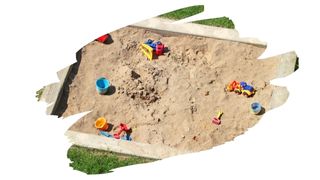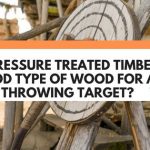Sandboxes can be so much fun for kids to play in.
But, ‘fun sandboxes’ must first and foremost be ‘safe sandboxes’. Which means that you need to be careful about which wood finishes or treatments you use on that wooden sandbox.
Now, pressure treated wood has earned a reputation for being the sort of timber you would not want to have your kids (or yourself) around.
But, is that reputation fair? Or is pressure treated wood possibly safe enough to use for your sandbox?
Well, in this post, you’ll learn which type of wood is so durable that it can last outside — untreated — for over 20 years. You’ll also learn why some treated woods are too dangerous to have around your home.
And keep reading to discover which clear wood preserving product offers the best non-toxic alternative to wood treatments.

This post may contain affiliate links to products that we receive a commission for (at no additional cost to you). Learn more here.
What Type Of Wood Should I Use For A Sandbox?
Any type of wood, that will spend a lot of time outdoors, needs to be very durable. This means that not only does it need to be fairly tough, it also needs to be naturally rot-resistant too.
Rot-resistant wood types have characteristics that allow them shrug off rainwater (and humidity) fairly easily. And this in turn helps to stave off decay.
So, one of the best types of wood for an outdoor sandbox is White Oak.
Why Is White Oak Rot-Resistant?
There are two good reasons why this hardwood does so well outside; Tyloses and Tannins.
Tyloses
Tyloses are unique cell growths that form over the wood pores of White Oak. They then act kind of like a stopper, preventing water from being absorbed into this lumber.
And anything that prevents water from soaking into timber in turn helps to prevent wood rot.
Tannins
White Oak also contains a lot of a compound called Tannins.
Tannins are found in plants and trees everywhere, but Oak is uniquely saturated with this natural chemical. Tannins are basically a natures-own fungicide, fighting off the bacteria responsible for wood rot.
And How Long Does Untreated Oak Wood Last?
It depends on how much prolonged ground contact that Oak wood will have to go through. If it is kept off the ground, it can last for over two decades.
However, if it has direct ground contact, then untreated White Oak will last around 8-10 years.
Related Post: Can You Really Use Untreated Oak For Raised Beds?
What About Pressure Treated Oak Wood? Will That Last Longer?
Pretty much, yes.
Treated wood is any lumber that’s been put through a pressure treatment process. This process involves infusing wood with wood preserving chemicals.
Those chemicals act like a fungicide, since their job is to fight off the bacteria responsible for wood rot — much like White Oak’s natural Tannin’s do.
Untreated Oak — if it repeatedly goes through cycles of becoming damp and drying out — will decay. It might take longer than most other types of lumber, but it will happen.
But, treated Oak wood will last much longer, especially in outdoor conditions.
And Is Pressure Treated Wood Safe Around Kids?
As a rule of thumb, no it is not.
There are many different kinds of treatment options when it comes to wood preservative infused timber. However, most of them are bad news when it comes to our personal health and safety.
The chemicals used in these wood preserving treatments is often very toxic — certainly much too toxic for kids to be near.
For example, some types of treatments can contain Chromated copper arsenate (CCA), which contains arsenic. Having said that, these particularly dangerous wood treatments have been banned from being used on wood meant for residential properties.
Related Post: How To Keep Your Landscape Timbers From Ever Warping Again
Is All Pressure Treated Wood Toxic To Us? Or Are There Any Safe Treated Timbers Out There?
There is a much safer type of treated wood called ‘green-treated’ wood. Green-treated wood is safer because it contains water-soluble chemicals that are safe around humans.
For example, one popular green treated wood preservative is Alkaline Copper Quaternary (ACQ). This wood preservative contains Copper Oxide.
Copper oxide, (also referred to as Cupric Oxide), can be found in some multivitamin products.
ACQ’s copper content is also the reason why this green treated wood has a green colored hue to it. This is because the copper in it reacts with the oxygen in the air (known as oxidizing).
In fact, ACQ green treated wood is the most low-risk treated wood you can use. And that’s why the E.P.A. (U.S. Environmental Protection Agency), have approved it’s use around your garden.
Is Green Treated Wood Safe To Use For A Sandbox?
Well, the safety of treated wood is relative. Nevertheless, ACQ treated wood is much, much safer than CCA treated timber.
In fact, it is safe enough to be used around farms. And it can also be used to build raised beds for a vegetable garden. So ACQ treated wood can be used to build a sandbox.
However, green treated wood is expensive. So, instead, it’s much cheaper to simply use untreated wood, and then ‘treat’ it yourself.
And How Do You Safely ‘Treat’ A Sandbox Made From Untreated Wood?
By coating it with a non-toxic wood preserving finish.
Now ideally, this wood preservative should be designed for exterior use — since your sandbox is obviously situated outdoors. So, because of this, you should coat that sandbox in Cuprinol’s Clear Wood Preserver.
Cuprinol’s odorless clear preservative is both human and pet safe — so it’s perfectly fine to apply onto everything from a sandbox to a chicken coop.
Related Post: Is There A Safe Non-Toxic Wood Sealer For Chicken Coops?
What’s more, it is incredibly easy to apply, as it will sink right down into wood, protecting it from the inside out.
You can learn more about Cuprinol Wood Preserver over on Cuprinol’s official website here.
It’s also worth noting here, that this is a base coat product. Which means it’ll need a top coat over it to finish things off.
In other words, you will need to apply a coat of paint or wood sealer over it.
To Wrap Up, Here Are The 3 Key Takeaways From This Post…
- 1). Pressure treated wood is often infused with toxic chemical wood preservatives that are too dangerous for children to be around.
- 2). However, ACQ green treated wood is a safer type of treated wood. It’s E.P.A. approved for use in and around residential properties.
- 3). Ideally, only use untreated wood for a sandbox. And then treat the wood yourself with a non-toxic wood preservative.
References:
Treated Wood In The Landscape | Home & Garden Information Center



